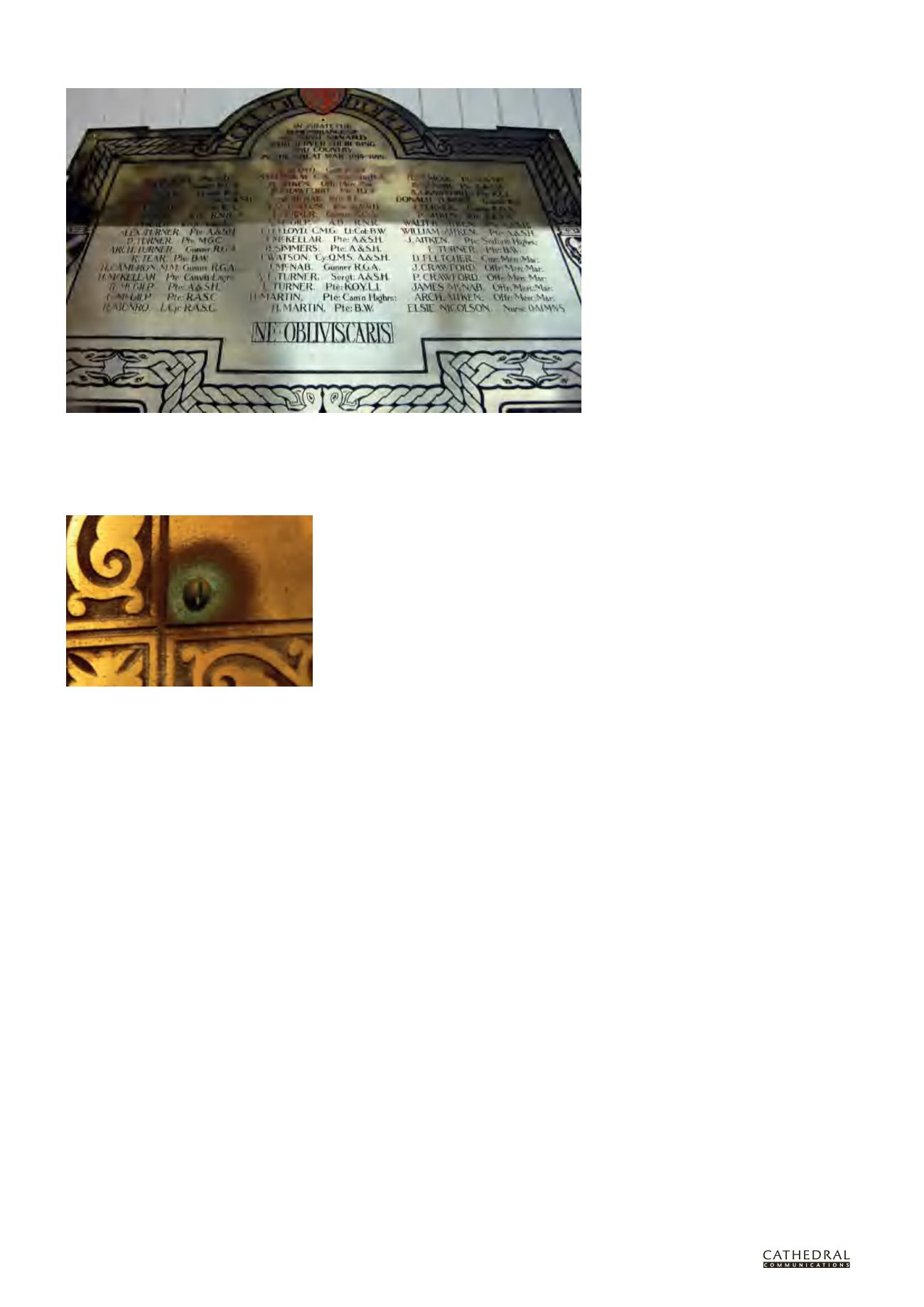

26
BCD SPECIAL REPORT ON
HISTORIC CHURCHES
22
ND ANNUAL EDITION
appropriate protective equipment when
using solvents such as white spirit.
Handling brass with bare hands, as
has been mentioned, leaves oils and salts
on the surface which cause tarnishing,
so surfaces frequently touched such
as a chancel rail will benefit from
light burnishing with a soft cloth on a
regular basis. If this proves ineffective in
preventing tarnish, the use of a microfibre
cloth designed for polishing metals such
as brass may be helpful. If necessary,
consider using a special brass polishing
cloth that has been impregnated with
mild abrasives and cleaners.
If the brass item has a thin patchy
coat of tarnish, then the use of cloths may
not be effective, and in such cases brass
polishes should be considered. These
come in a great variety, from the gentle to
the strong, and it is really a case of horses
for courses when it comes to choosing a
polish. Some conservators tend to avoid
those brass polishes that leave a powdery
residue in recesses, as these can be difficult
to remove once they have dried out, and
sometimes the rather coarse abrasive
can remove more metal than might be
desired, but classic products like Brasso
polish are still in use in many places.
More gentle options include Duraglit
brass polishing wadding and Brasso brass
polishing wadding, which are based on
petroleum spirit rather than water and
thus must only be used while wearing
gloves. These waddings tend to turn black
when polishing the brass, but careful
burnishing after polishing should bring
up a bright surface and remove any visible
dark residues.
The National Trust’s
Manual of
Housekeeping
encourages staff and
volunteers who need to polish brass to use
Solvol Autosol, a metal polish designed for
use on a wide range of metals. It is a fairly
strong and effective cleaning and polishing
agent so should be used with care. It can
certainly be useful when more gentle brass
polishes such as the wadding polishes have
failed to make an impact. It too turns black
as it is used, and if fully burnished out it
should not leave any visible residues.
Many commercial polishes contain
a mixture of abrasives, chemicals and
waxes. The ingredients of any commercial
product can often be discovered by
searching online for the product name
and the MSDS, or Material Safety Data
Sheet, which will provide information
about ingredients and the health and safety
issues involved in the use of the product.
The waxes that are included in polishes
are designed to remain on the surface
and provide a protective layer against
future tarnishing. This is, in principle, a
good idea but the wax layer tends to trap
abrasives, chemicals, metal fragments
and anything else that was on the surface
during polishing. Some conservators
remove the wax and other polish residues
by wiping down the surface with a paper
towel or soft cloth moistened slightly with
white spirit. Once all the black residues
have come away, the surface may be
considered to be reasonably clean.
Of course having the wax present is
a good idea, as some protection against
future tarnishing is certainly helpful. Some
institutions go so far as to have protective
lacquers applied to their freshly-polished
brass, and this can give many years of
protection to those items that do not
see hard use. However, if the lacquer is
damaged, it can lead to rapid tarnishing
in the areas where metal is exposed,
and then there are decisions to be made
about removal and/or replacement,
which may require special facilities.
A better answer is a conservation-
grade wax polish such as Renaissance
Wax. Widely used by conservators, this
wax forms a clear self-healing coating
on bright metals. It protects to a great
extent against dust and humidity as well
as handling and tarnish. It can easily
be revived by the application of more
Renaissance Wax once a year, or as
required. It is easily removed with a soft
cloth moistened with a little white spirit.
If polishing the brass, the wax does not
resist the polishing process, and does not
have to be specially removed beforehand.
The only situation where Renaissance
Wax might not be useful is where there is
a great deal of complex decoration and it
would prove difficult to buff the wax up
to a good shine, or on uneven and porous
materials such as unvarnished wood
where again the wax will be difficult to
buff to a transparent coating.
Finally, when it comes to badly-
damaged brass artefacts, repair is best left
to expert metalworkers. Such conservation
work might include annealing and
reshaping the metal, or joining broken
parts using the correct brazing techniques
or perhaps the use of cold-setting resins
such as epoxy resin. The use of soft lead
solder is often seen on brasswork that has
been repaired by amateurs wishing to be
of assistance, but the results leave much to
be desired as dull grey lead has no place on
bright yellow brass.
A list of accredited decorative
metalwork conservators can be found
at the Conservation Register, www.
conservationregister.com.
WILL MURRAY
is an accredited conservator
and a partner in The Scottish Conservation
Studio LLP, a private-sector conservation
provider based at Hopetoun House near
Edinburgh. The studio specialises in the
conservation of paper and photographs,
costume and textiles, and artefacts and objects.
Its conservators also provide preventive
conservation advice, collection surveys and
training for museum staff and volunteers.
A war memorial from Minard, Argyll (above) part
way through cleaning showing patchy tarnishing in
the uncleaned areas which make the roll of honour
difficult to read, and (below) a detail of a plaque with
bimetallic corrosion around a fixing (Both photos:
Will Murray)
















